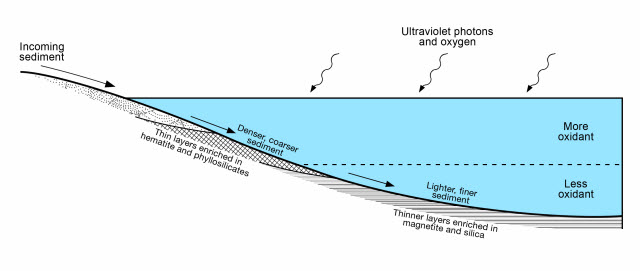Mars Rover Reveals Ancient Lake with Properties Common to Those on Earth
Findings published in the journal Science
 Sedimentary rocks from three locations on lower Mount Sharp on Mars examined by NASA’s Curiosity rover provide examples of different textures interpreted as sediments deposited at different depths within a long lived lake. This example exhibits thicker layers which occur at the edge of a lake where sediment-bearing water enters the lake, slows down and drops much of its sediment.Image Credit: NASA/JPL-Caltech/MSSS
Sedimentary rocks from three locations on lower Mount Sharp on Mars examined by NASA’s Curiosity rover provide examples of different textures interpreted as sediments deposited at different depths within a long lived lake. This example exhibits thicker layers which occur at the edge of a lake where sediment-bearing water enters the lake, slows down and drops much of its sediment.Image Credit: NASA/JPL-Caltech/MSSS
 This example is with thinner layers and is interpreted as deposition that occurred father from the edge of the lake, in deeper water.Image courtesy of Stony Brook UniversityStony Brook, NY – New findings based on NASA’s Curiosity rover mission reveal that an ancient lake in Gale Crater on Mars had chemical and physical properties very similar to those common to lakes on Earth. The study, led by Stony Brook University geoscientist Joel Hurowitz, PhD, published in Science, provides evidence that there were multiple environments in the lake that could have supported life.
This example is with thinner layers and is interpreted as deposition that occurred father from the edge of the lake, in deeper water.Image courtesy of Stony Brook UniversityStony Brook, NY – New findings based on NASA’s Curiosity rover mission reveal that an ancient lake in Gale Crater on Mars had chemical and physical properties very similar to those common to lakes on Earth. The study, led by Stony Brook University geoscientist Joel Hurowitz, PhD, published in Science, provides evidence that there were multiple environments in the lake that could have supported life.
Previous work with the Curiosity rover revealed the presence of a lake more than three billion years old in the crater. This study defines the chemical conditions that existed in the lake and uses Curiosity’s powerful payload to determine that the lake was stratified. Stratified bodies of water exhibit sharp chemical or physical differences between deep water and shallow water. In Gale’s lake, shallow water was richer in oxidants than deeper water.
 This example shows very think laminations, characteristic of sediment deposition from water that has become quite still, in the deepest part of the lake.Image courtesy of Stony Brook University“These were different, co-existing environments in the same lake,” said Hurowitz, an assistant professor in the Department of Geosciences and lead author of the paper titled Redox stratification of an ancient lake in Gale crater, Mars. “This type of oxidant stratification is a common feature of lakes on Earth, and now we have found it on Mars.”
This example shows very think laminations, characteristic of sediment deposition from water that has become quite still, in the deepest part of the lake.Image courtesy of Stony Brook University“These were different, co-existing environments in the same lake,” said Hurowitz, an assistant professor in the Department of Geosciences and lead author of the paper titled Redox stratification of an ancient lake in Gale crater, Mars. “This type of oxidant stratification is a common feature of lakes on Earth, and now we have found it on Mars.”
Hurowitz emphasized that the diversity of environments in this Martian lake would have provided multiple opportunities for different types of microbes to survive, including those that thrive in oxidant-rich conditions, those that thrive in oxidant-poor conditions, and those that inhabit the interface between both conditions.
The international team of 22 scientists (co-authors of the paper) also document fluctuations in the climate of ancient Mars. The method the team used for detecting changes in ancient climate conditions on Mars resembles how ice cores are used to study past temperatures on Earth. It is based on comparing differences in the chemical composition of layers of mud-rich sedimentary rock that were deposited in quiet waters of the lake.
These new results from Curiosity pave the way for future NASA rover missions to Mars, such as the Mars 2020 rover mission, which will find and explore the Martian rock record in search of possible signs of ancient life.
 This diagram presents some of the processes and clues related to a long-ago lake on Mars that became stratified, with the shallow water richer in oxidants than deeper water was.Image Credit: NASA/JPL-Caltech/Stony Brook University
This diagram presents some of the processes and clues related to a long-ago lake on Mars that became stratified, with the shallow water richer in oxidants than deeper water was.Image Credit: NASA/JPL-Caltech/Stony Brook University
